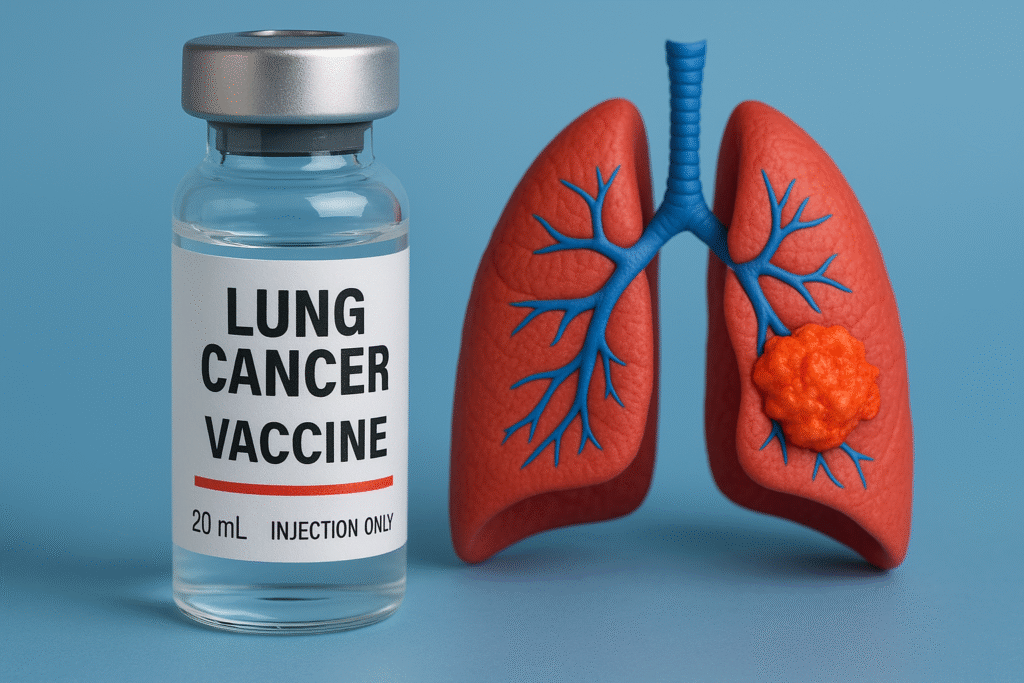Introduction: A Groundbreaking Moment in Oncology
Lung cancer remains the deadliest cancer globally, claiming approximately 1.8 million lives annually. For decades, treatment has relied on a triad of surgery, chemotherapy, and radiation—often with devastating side effects and limited success in advanced stages. But today, we stand at the precipice of a revolution. The world’s first mRNA lung cancer vaccine, BNT116, has entered human clinical trials across seven countries, offering unprecedented hope for patients and oncologists alike.
This vaccine represents a paradigm shift—a therapeutic approach designed not to prevent cancer, but to train the immune system to hunt down existing cancer cells and prevent their return. In this comprehensive analysis, we explore the science, the trials, and the profound implications of this breakthrough.

The Science Behind the Vaccine: How mRNA Technology Conquers Cancer
1. The Core Mechanism: Turning Tumors into Targets
Unlike traditional vaccines that prevent disease, therapeutic cancer vaccines treat existing malignancies. BNT116 uses messenger RNA (mRNA) technology—pioneered during the COVID-19 pandemic—to deliver genetic blueprints of tumor-specific antigens (proteins found only on cancer cells). Once injected, these instructions teach immune cells to:
- Recognize cancer cells as foreign invaders
- Launch targeted attacks while sparing healthy tissue
- Establish long-term immunological memory against recurrence
2. Overcoming Immune Evasion
Lung cancer cells notoriously “hide” from the immune system. Researchers at Leiden University Medical Center identified a key protein called TEIPP that acts like an “antenna” on these stealthy cells. The vaccine exposes these markers, making tumors visible to T-cells. As Prof. Sjoerd van der Burg explains:
“We’ve developed a vaccine that forces previously invisible cancer cells into the open. Early results show immune reactivation in over 80% of patients”.
3. Personalization: The Future of Precision Oncology
Each patient’s vaccine is customized using genetic sequencing of their tumor. For non-small cell lung cancer (NSCLC)—the most common subtype—this means targeting up to 34 neoantigens unique to the individual’s cancer profile. This hyper-personalization is why vaccines like mRNA-4157 (Moderna/Merck) show a 44% reduction in recurrence risk in melanoma trials.
Global Clinical Trials: Structure, Scope, and Early Results
1. Phase 1 Trial Design
Led by University College London Hospitals NHS Foundation Trust, the trial spans 34 sites in the UK, US, Germany, Hungary, Poland, Spain, and Turkey. Key features:
- Participants: 130 patients with NSCLC (stages I-IV)
- Protocol: Weekly vaccines for 6 weeks, followed by boosters every 3 weeks for 54 weeks
- Combination Therapy: All patients receive immunotherapy (e.g., pembrolizumab) alongside vaccines to amplify response.
2. Promising Early Outcomes
While survival data remain preliminary, immune activation is striking:
- T-cell proliferation: Significant increases observed in pancreatic cancer vaccine trials, with immune cells surviving 7.7+ years post-booster.
- Safety: Only mild side effects (e.g., injection-site pain, flu-like symptoms) reported.
- Patient Impact: UK trial participant Janusz Racz, a 67-year-old scientist, received his first dose in 2024. His motivation: “I can be part of the proof of concept that saves thousands”.
3. Parallel Advances
Complementary vaccine approaches show similar promise:
- Peptide Vaccines: “Off-the-shelf” options targeting KRAS mutations (e.g., G12D) achieved 12.75x higher T-cell levels in pancreatic/colorectal cancers.
- Viral Vector Vaccines: TG4050 (Transgene) reduced head/neck cancer relapses by 20% in early trials.
Table: Comparing Lung Cancer Vaccine Platforms
| Type | Example | Advantages | Limitations |
|---|---|---|---|
| mRNA | BNT116 | Highly personalized; strong immune response | Costly; long production time |
| Peptide | KRAS-targeted | Rapid production; low cost | Less personalized; weaker efficacy |
| Viral Vector | TG4050 | Potent immune activation; AI-enhanced | Complex manufacturing |
Why Now? The Perfect Storm of Scientific Advances
Three breakthroughs enabled this milestone:
- Genomic Sequencing: Since 2008, the ability to sequence tumor DNA has revealed thousands of targetable mutations.
- Immunotherapy Synergy: Checkpoint inhibitors (e.g., pembrolizumab) “release the brakes” on immune cells, enhancing vaccine efficacy.
- mRNA Optimization: COVID-19 vaccine mass production refined delivery systems like lipid nanoparticles.
As Prof. Siow Ming Lee (UCLH) notes:
“After 40 years in lung cancer research, I’ve never seen such potential. This could become standard care worldwide”
Challenges and Ethical Considerations
Despite excitement, hurdles remain:
- Cost: Personalized vaccines may exceed $100,000 per dose
- Manufacturing: Creating bespoke vaccines takes 1–3 months—a barrier for rapidly progressing cancers
- Accessibility: Trials are limited to high-income nations; Ukraine’s lower-cost CANCERAX vaccine offers an alternative model
- Trial Diversity: Early participants are predominantly White; expanding recruitment is critical
Beyond Treatment: Vaccines for Prevention
While BNT116 treats existing cancer, preventive vaccines are also advancing:
- LungVax: Developed by Oxford University and Cancer Research UK, this AstraZeneca-based vaccine targets high-risk smokers (55–74 years) to stop lung cancer.
- Screening Integration: Combining vaccines with low-dose CT scans and liquid biopsies could slash mortality.
Patient Stories: The Human Face of Innovation
Janusz Racz’s Journey
Diagnosed in May 2024, the London-based AI scientist embraced the trial as both patient and researcher. His regimen: six initial injections in 30 minutes, followed by a year of boosters. His goal: “To run the London Marathon when this is over”.
Real-World Impact
For stage IV NSCLC patients, 5-year survival remains below 20% 5. Vaccines could extend this dramatically—pancreatic cancer vaccine recipients saw 88% metastasis-free survival at 18 months.
The Future Landscape: What’s Next?
- Combination Therapies: Pairing vaccines with KRAS inhibitors (e.g., zoldonrasib) or antibody-drug conjugates.
- AI-Driven Design: NEC Corporation’s AI platform accelerates neoantigen selection for viral vaccines.
- Phase 2/3 Trials: Planned for 2026–2027; if successful, FDA approval by 2030
As Dr. Mark Awad (Memorial Sloan Kettering) emphasizes:
“We’re entering immunotherapy’s golden age. Soon, ‘terminal’ lung cancer may become a chronic disease”.
Conclusion: A Turning Point in the War on Cancer
The BNT116 trial marks more than scientific progress—it embodies a philosophical shift from reactive treatment to proactive immune empowerment. While challenges persist, the fusion of mRNA technology, personalized medicine, and global collaboration heralds a future where lung cancer’s lethality is neutered.
As trials expand, public support through awareness and funding remains crucial. For the 10,000+ patients diagnosed yearly in the UK alone, the vaccine isn’t just hope—it’s a lifeline
References:
- The Guardian. (2024, August 23). World-first lung cancer vaccine trials launched across seven countries. Retrieved from https://www.theguardian.com/society/article/2024/aug/23/world-first-lung-cancer-vaccine-trials-launched-across-seven-countries
- Celona, T. (2025, April 30). Cancer vaccines show promise in early trials. Cancer Today. Retrieved from https://www.cancertodaymag.org/cancer-talk/cancer-vaccines-show-promise-in-early-trials/
- MedTour. (2025). Cancer vaccines: A breakthrough expected in 2025. Retrieved from https://medtour.help/cancer-vaccines-a-breakthrough-expected-in-2025/
- American Association for Cancer Research. (2025, May 16). Old, new, borrowed, and blue: Clinical trial results highlight therapeutic approaches for non-small cell lung cancer. Retrieved from https://www.aacr.org/blog/2025/05/16/old-new-borrowed-and-blue-clinical-trial-results-highlight-therapeutic-approaches-for-non-small-cell-lung-cancer/
- Leiden University Medical Center. (2025, June 2). New vaccine makes hidden lung cancer cells visible to the immune system. Retrieved from https://www.lumc.nl/en/news/2025/vaccine-against-lung-cancer/
- Grisham, J. (2025). Lung cancer treatment advances from MSK presented at 2025 ASCO meeting. Memorial Sloan Kettering Cancer Center. Retrieved from https://www.mskcc.org/news/msk-researchers-present-advances-in-lung-cancer-treatment-at-2025-asco-meeting
- Stallard, J. (2025). New lung cancer treatments aim to reduce deaths in 2025 and beyond. Memorial Sloan Kettering Cancer Center. Retrieved from https://www.mskcc.org/news/new-lung-cancer-treatments-aim-to-reduce-deaths-in-2025-and-beyond
- Institut Curie. (2025). ASCO conference 2025: A landmark year for Institut Curie. Retrieved from https://institut-curie.org/asco2025


